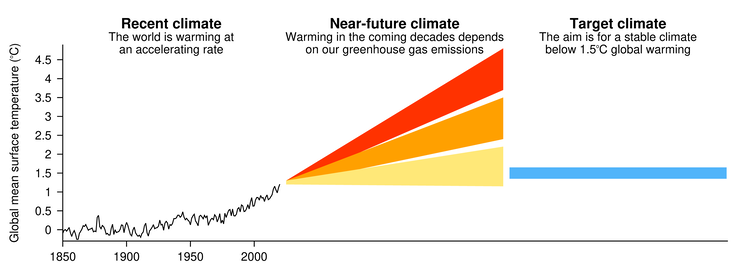
Image credit: Shutterstock
There’s a big question mark over whether the world will keep global warming below the limits set out in the Paris Agreement. But even if we do, the climate will keep evolving – and society needs to prepare for this.
At the moment, climate models don’t tell us much about a future world in which temperatures have stabilised. As our research published today argues, new model experiments are needed to close this knowledge gap and better understand the challenges ahead.
For example, in southern Australia, climate change has already caused a trend towards less rain and more frequent and prolonged drought. If the global climate stabilises, we expect this drying trend to reverse, which could ease future strains on water supply in this region. This would in turn affect urban planning, agriculture and water policy.
The new models we’re proposing would enable more useful climate projections aligned with the Paris Agreement targets – and better prepare society for a warmer, but more stable, global temperature.
Targeting a stable climate
Under the landmark Paris Agreement, the world is aiming to keep global warming well below 2℃ compared with pre-industrial times, and preferably below 1.5℃.
The world is warming at a rate of around 0.25℃ per decade and is already about 1.2℃ warmer than in pre-industrial times.
This warming won’t stop until net greenhouse gas emissions are near zero. If we don’t greatly reduce emissions in the next decade, we will warm the planet beyond 1.5℃.

The world has warmed and will continue to warm in the coming decades but the Paris Agreement targets a stabilised future climate with low global warming.
To date, climate simulations used to examine the implications of the Paris Agreement either assume warming continues beyond 1.5℃ and 2℃, or only examine a short period after warming has stopped. This is because most of these simulations were not specifically designed to analyse global warming levels linked to the Paris Agreement, and mostly focus only on what will happen this century.
If we manage to stabilise global temperatures, other aspects of Earth’s climate would continue to change. Studies based on long model experiments suggest ocean and land temperatures continue to evolve for centuries after global warming slows. That’s because the ocean warms at a slower rate than the land, and warming water can take hundreds, and even thousands, of years to mix into the deep ocean.
Even after the global temperature stabilises at the levels set out in the Paris Agreement, many ocean areas would likely warm by at least a further 0.5℃. Meanwhile some land areas would cool by at least 0.5℃.
The ocean takes time to catch up – and as it does, land temperatures have to fall to maintain the same global average temperature.
In addition, if global temperature remained near-constant, rainfall patterns would likely change. In some subtropical regions, such as southern Australia, this might mean a reversal of the drying trends we’ve seen over the past few decades.

The ocean takes time to catch up to global warming. Image credit: Shutterstock
New models are needed
Clearly, we need new experiments to model Earth’s climate if warming is stabilised at 1.5℃. Our new paper proposes a framework for designing these experiments.
Our framework differs from the approach taken by various climate modelling groups around the world in recent decades.
These groups have all used the same projection of greenhouse gas concentrations in the atmosphere, and how they change through time. This approach allows for comparison of climate projections between models for the same greenhouse gas scenarios.
But because each group fed this projection into their own climate model – each with their own characteristics – each produced different predictions for how much global warming would occur. Also, these model simulations are mostly run only to 2100, and so represent a world that’s continuing to warm and hasn’t had time to stabilise.
Instead, our framework involves reaching the same level of global warming across a range of climate models. This would be achieved by “turning off” the carbon emissions used in various climate models at different times.
So, a climate model that warms more strongly in response to greenhouse gas emissions would have its carbon emissions “turned off” earlier, relative to a slower warming model. This would provide a group of climate model simulations at around the same level of global warming.
Stopping carbon emissions will cause global warming to slow and, eventually, stop. Running these simulations for up to 1,000 years after carbon emissions stop will allow us to investigate and understand the effects of climate stabilisation in line with the Paris Agreement.
A few global modelling centres have started running simulations following similar frameworks, including Australia’s CSIRO. We invite other climate modelling centres to join us in our experiments, and help policymakers and societies better prepare for a warmer world.
This article is republished from The Conversation under a Creative Commons license. Read the original article.

